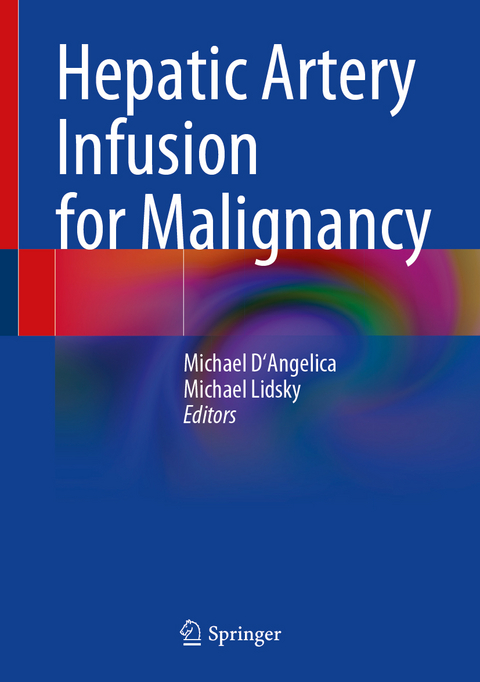
Hepatic artery Infusion for Malignancy
Springer International Publishing (Verlag)
978-3-031-74934-6 (ISBN)
- Noch nicht erschienen - erscheint am 19.01.2025
- Versandkostenfrei
- Auch auf Rechnung
- Artikel merken
Hepatic artery infusion (HAI) chemotherapy most commonly entails the surgical implantation of a subcutaneous pump with a catheter that is inserted into the hepatic arterial system, allowing for the delivery of high-dose chemotherapy directly to the liver, typically given concurrently with systemic chemotherapy. The primary agent delivered via HAI is floxuridine (FUDR), which has the ideal properties of a short half-life (<10 minutes) and near-complete hepatic clearance, such that drug concentrations in the liver reach up to 400 times that which could be achieved with intravenous delivery, but without systemic exposure/toxicity.
This text is the gold standard comprehensive resource encompassing much more than the essentials of hepatic artery infusion therapy. Written by experts in the field, sections include a historical perspective of transarterial therapies and how implantable devices were developed, as well as the therapeutic optimization that has taken place over many decades. Subsequent chapters address key components of the preoperative evaluation and patient selection criteria, and surgeons will benefit from the thorough review of the conduct and nuances of pump implantation, inclusive of how to overcome commonly encountered intraoperative obstacles. The reader, regardless of their role on the HAI team, will have access to a toolkit to aid in diagnosis and management of commonly encountered complications, allowing insight into perioperative management of these complex patients. Furthermore, medical oncologists will benefit from exhaustive details pertaining to pump and systemic chemotherapy dosing and delivery, with specific attention to modifications that will facilitate improvements in HAI safety and therapeutic efficacy. This all-inclusive text also includes a thorough review of the existing body of literature, which will provide all readers with evidence-based context and justification for using HAI for specific patient populations. The book concludes with sections focused on essential steps for new HAI program implementation and sustainability, as well as the future of HAI, including device and drug development, and alternative transarterial chemotherapy delivery strategies.
This HAI reference includes extensive illustrations and figures for visual clarity. Accompanying this book is a video atlas demonstrating technical maneuvers for open and robotic HAI pump implantation, management of aberrant anatomy and intraoperative troubleshooting, as well as instructional videos for how to prime, access, bolus, and refill the pump, all of which are key components of maintaining a functional device. It is the only reference that provides a comprehensive review of all aspects of HAI for all specialists and providers of a multidisciplinary HAI team.
Michael D’Angelica, MD, Department of Surgery, Memorial Sloan Kettering Cancer Center, Weill Cornell Medical College, New Nork, NY, USA Michael Lidsky, MD, Division of Surgical Oncology, Department of Surgery, Duke University, Durham, NC, USA
Part I. History of HAI.- Philosophy and rationale for liver-directed therapy (includes history of catheter-based chemotherapy delivery).- Transarterial therapies and Early History/Trials of HAI.- Device Development: development of implantable reservoir-based pump.- Optimization of therapy: Drug development, pharmacokinetics, pharmacodynamics.- Part II. HAI Perioperative and Operative Considerations.- Preoperative Evaluation.- Conduct of Open HAIP placement.- Conduct of MIS HAIP placement.- Concurrent procedures and perioperative care/postoperative considerations.- Pre-HAI Perfusion Scans.- HAI Pump-Specific Complications and Management.- Part III. HAI Delivery.- HAI Drugs.- Concurrent Systemic Therapy.- Duration, maintenance, and secondary use of HAI.- Part IV. HAI Patient Selection and Efficacy.- Unresectable CRLM.- Adjuvant HAI for resected CRLM.- Intrahepatic cholangiocarcinoma.- Other indications: HCC, NET, Breast, Pancreas Cancer.- Part V. Long-Term Consequences of HAI.- Biliary sclerosis.- Hepatic Failure.- Termination of HAI and Pump Removal.- Transplant after HAI.- Part VI. Starting a New HAI Program.- Recruitment of a team.- Device and drug procurement.- Regulatory/IRB Considerations.- Training a new HAI team.- HAI Site Visits.- Early Patient Selection.- Patient education.- International Perspective.- Part VII. The Future of HAI.- Device development: the future.- Drug development.- Part VIII. Alternative Approaches to HAI delivery.- Complete percutaneous delivery.- Reservoir-less ports.- Part IX. HAI Video Atlas.- Open HAI pump implantation.- Robotic HAI pump implantation.- Accessing HAI pump reservoir.- Accessing HAI pump bolus port.- Priming the HAI pump.
| Erscheint lt. Verlag | 19.1.2025 |
|---|---|
| Zusatzinfo | Approx. 350 p. 100 illus., 50 illus. in color. With online files/update. |
| Verlagsort | Cham |
| Sprache | englisch |
| Maße | 178 x 254 mm |
| Themenwelt | Medizinische Fachgebiete ► Chirurgie ► Viszeralchirurgie |
| Medizin / Pharmazie ► Medizinische Fachgebiete ► Onkologie | |
| Schlagworte | Biliary sclerosis • Colorectal Liver Metastases • Hepatic artery chemotherapy • Hepatic artery infusion (HAI) • Hepatic failure • Intrahepatic Cholangiocarcinoma • Liver-directed therapy • Locoregional therapy • Pump chemotherapy • Transarterial therapy |
| ISBN-10 | 3-031-74934-0 / 3031749340 |
| ISBN-13 | 978-3-031-74934-6 / 9783031749346 |
| Zustand | Neuware |
| Haben Sie eine Frage zum Produkt? |
aus dem Bereich


